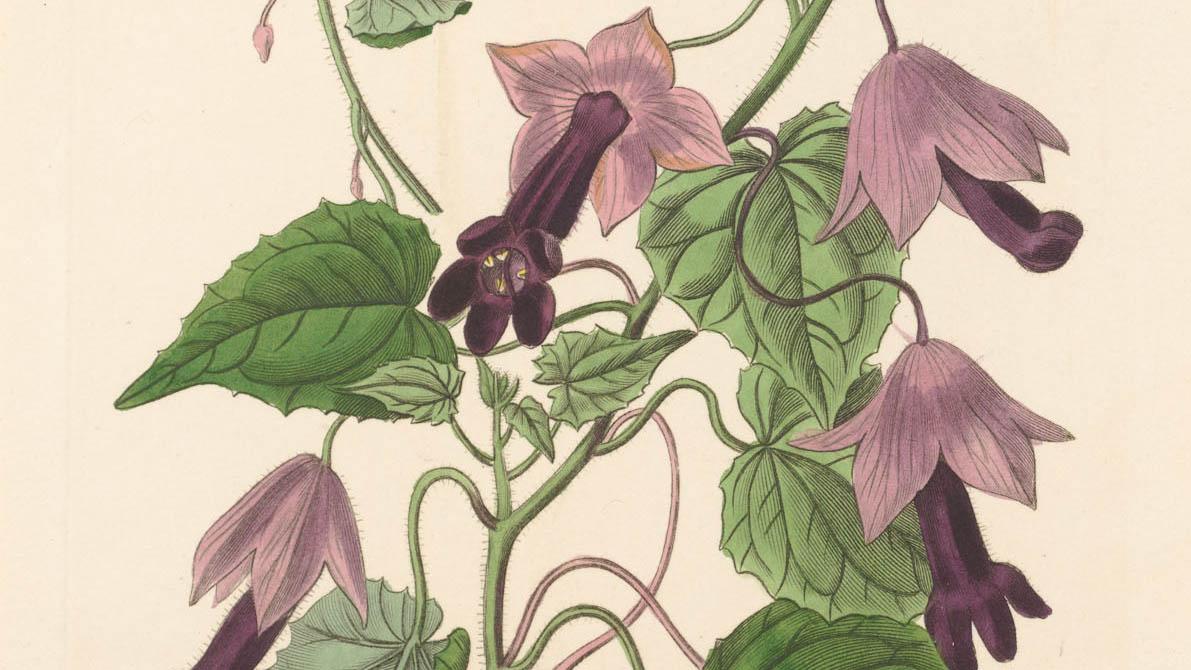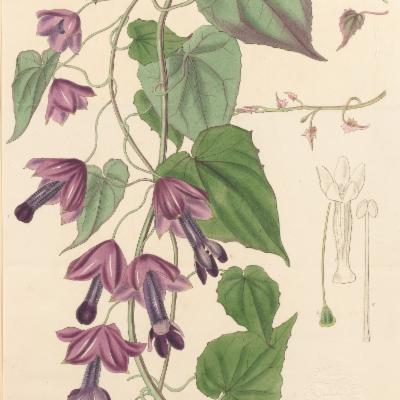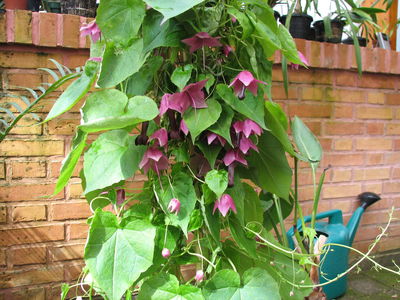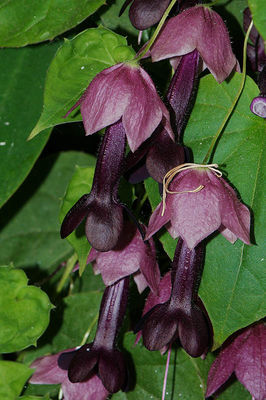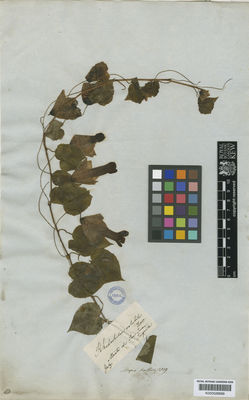Geography and distribution
Native to southern Mexico, where it occurs in the north-eastern part of the state of Oaxaca. It has been found near San Juan Juquila and in the Sierra de Juarez, north-east of Oaxaca city, at 2,300-2,500 m above sea level and elsewhere in northern Oaxaca at 1,500-3,500m. It climbs in scrub and the lower branches of trees, in cool, deep valleys.
Description
A perennial with stems climbing up to around 3 m high. The leaves are heart-shaped, up to 5 cm long and pale green, with shallow lobes. The petioles (leaf stalks) curl around any support. The flower stems are slender, pendent and about 6 cm long. The calyx is umbrella-shaped, with five broad lobes, and 4 cm across. The corolla is 4.5 cm long and blackish-purple, with five rounded lobes. The stamens have contrasting white pollen. The style is slender and undivided. The fruit is a whitish, four-lobed capsule.
Illustration from Curtis's Botanical Magazine
The illustration of Rhodochiton atrosanguineus featured in Curtis's Botanical Magazine was created using an introduction by Baron Karwinski, who sent seed from Mexico to Munich in 1828. Following this, the species soon spread throughout the botanic gardens of Europe.
Threats and conservation
Rhodochiton atrosanguineus grows in densely forested areas and is not known to be threatened.
Uses
Purple bell vine is cultivated as an ornamental.
Theodore Hartweg's botanical exploration of Mexico
There have been few collections of Rhodochiton species from the wild. The specimen of Rhodochiton atrosanguineus in Kew's Herbarium was collected by Theodore Hartweg in 1839. Hartweg was employed by the Horticultural Society of London (now the Royal Horticultural Society) to collect seeds and plants, particularly orchids, in Mexico. Sir William Hooker, soon to become Director of Kew, wrote in The Companion to the Botanical Magazine in January 1837:
'Mr. Theodore Hartweg embarked for Mexico in the service of the Horticultural Society, to whom therefore all living plants, roots, and seeds will be sent: but that useful Institution has generously allowed him to dispose of dried specimens of plants on his own account, which he will do at the rate of pound 2 the hundred species. All applications, however, for shares must be made through the Horticultural Society, by letters addressed either to Mr. Bentham, or to Mr. Lindley. From the capital of Mexico, Mr. Hartweg will go to Guanaxato and proceed northward ...keeping as much as he can to the Tierra fria. He will remain in the country two or three years, that is, if the state of it will admit of botanizing; but it is so disturbed, that he may probably have to take another direction and visit Bolivia, which presents a yet more interesting field. Which ever way he goes, we are authorized in anticipating great things from him.'
Hooker was not to be disappointed; Hartweg made many valuable collections and travelled in South America until 1843. George Bentham published many of the new species in Plantae Hartwegianae (1839-1857).
This species at Kew
Purple bell vine can be seen growing in the grounds of Cambridge Cottage at Kew.
Pressed and dried specimens of Rhodochiton atrosanguineus are held in Kew's Herbarium, where they are available to researchers from around the world, by appointment. The details of one of these (collected by Theodore Hartweg in 1839), including an image, can be seen online in the Herbarium Catalogue.

